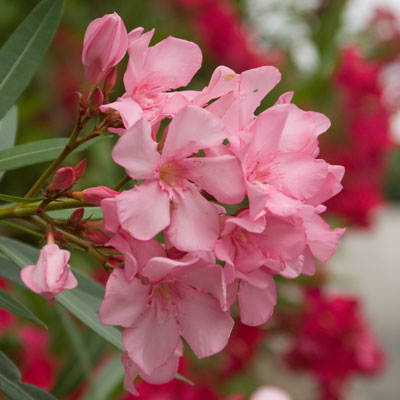Question of the Week Number 2: July 18, 2019
“Why are my crape myrtles and oleanders not blooming?”
I get this question many times every summer. Let me try to answer this way.
Things that could apply to both plants…
• Too much shade. These plants both need full sunlight. If you have shade trees that have overtaken them, it may come at the cost of the blooms.

• Freeze damage. This is more likely with oleanders. If you had to trim out dead growth after the winter, that’s the problem. However, several varieties of crape myrtles (notably, Natchez, Tuscarora and Muskogee frequently suffer freeze dieback). See my comments beneath the very next bullet.
• Wintertime pruning. If you did extensive pruning to either type of plant this past winter, whether to remove cold-weather injury or to “top” your crape myrtle (always a terrible practice), your plant has responded with vigorous new growth. That growth comes at the expense of flower production. Flower buds are produced as the growth becomes more mature.
• Not enough new growth. Both of these plants do demand a certain amount of vigor before they will produce buds. If the plants are lethargic for any reason, the cause needs to be determined and corrected. Crape myrtles need nitrogen fertilizer to promote new growth and subsequent flower bud production, but that would not be good for oleanders as it would probably lead to more vegetative growth. Both plants may just need more uniform watering.
A couple of personal opinions on the specific plants…
• Some varieties of oleanders are decidedly less winter-hardy than others. If you live in the northern parts of where oleanders are grown, you need to let your nursery professional guide you as to the types that are most likely to survive winters in your area without severe damage.
• To some degree the same thing could be said about crape myrtles. For example, there’s no point in trying the miniature, weeping crape myrtles with the Cajun variety names if you live in North Texas. Most of us along the I-20/30 corridor, at least in the DFW area, have learned that they struggle to survive even average winters.

• The more frustrating problem for me is when an old crape myrtle that has bloomed well for decades suddenly stops blooming. I don’t see it often, but when it does happen it’s frustrating. We have a few in the old, rural neighborhood where my wife and I live. The plants are probably 75 to 100 years old. Their trunks are huge and tall, yet the plants are sluggish about blooming. My guess would be that the landscapes don’t get much care, and that a bit more nitrogen and water would probably result in new growth and blooms.
